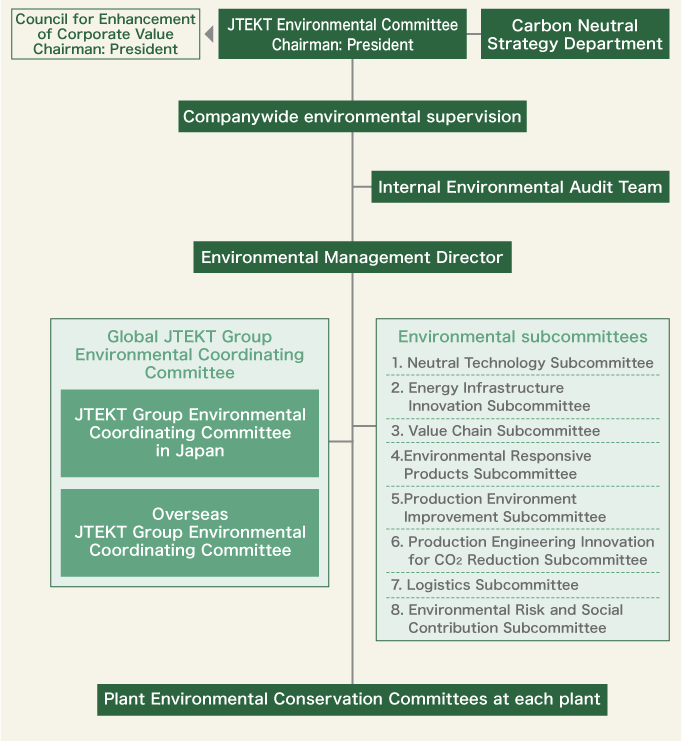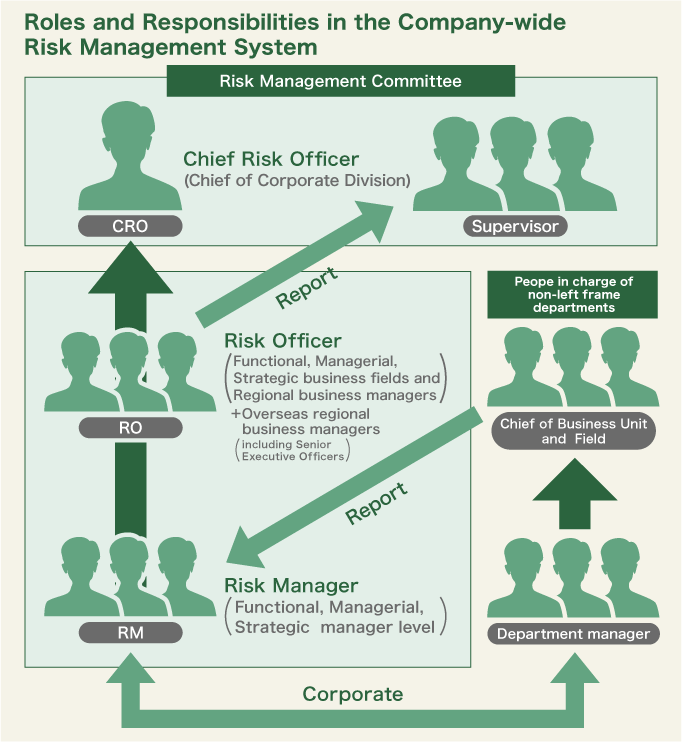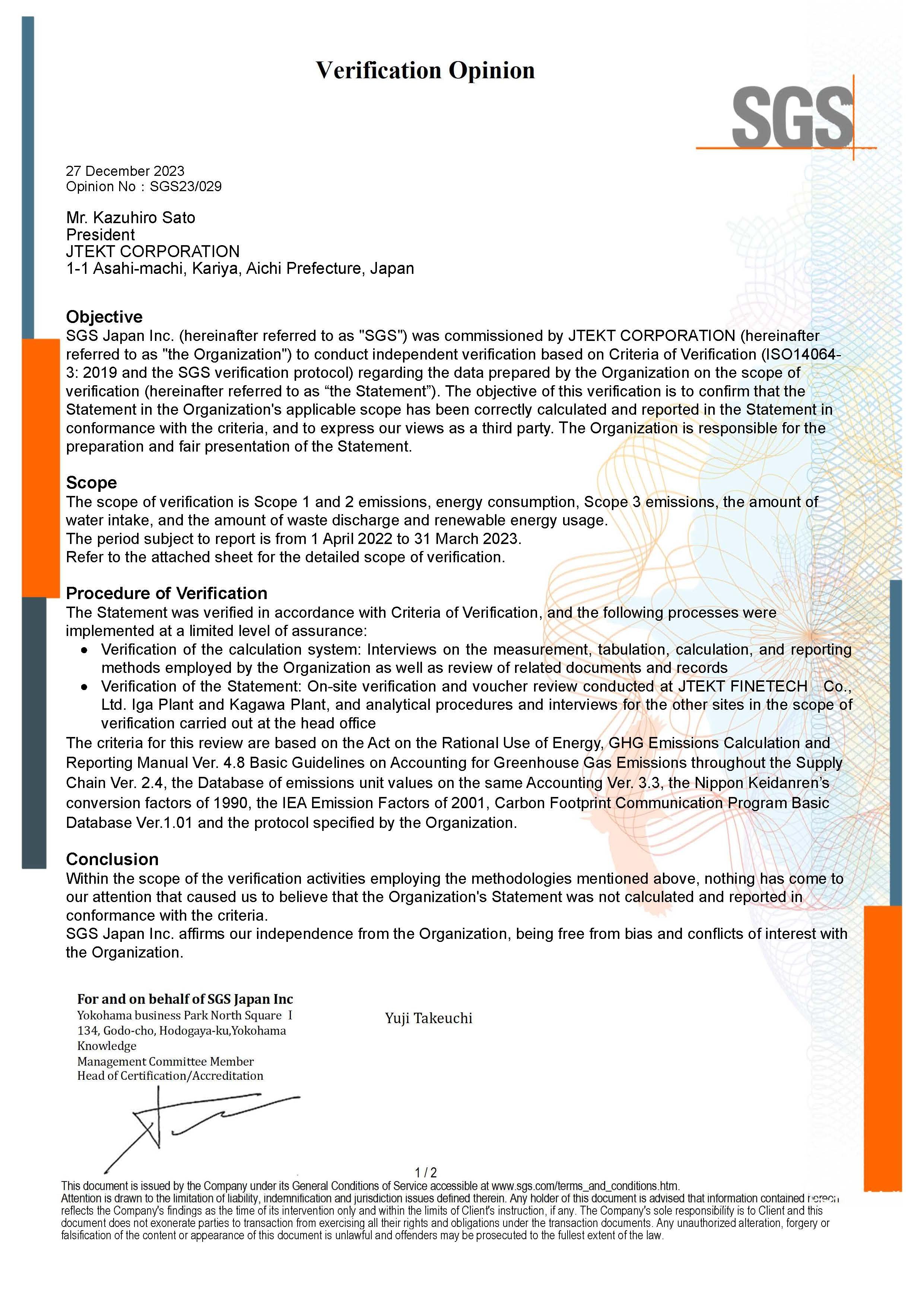- JTEKT TOP
- Sustainability
- Environmental Report
- Initiatives for TCFD
Initiatives for TCFD
JTEKT has a corporate philosophy of continuing to contribute to the earth, the world, and customers, aiming to be No.1 & Only One, placing the highest priority on human life,putting safety first and quality second. Based on this philosophy, we have determined that contributing to a society with a minimized environmental impact is an issue that the entire Group should address, and in 2016 we formulated the Environmental Challenge 2050. Environmental Challenge 2050 clearly states an action plan for environmental management based on the five pillars of "Products and Technologies," "Establishment of Low-carbon Society", "Establishment of Recycling Society","Society in harmony with nature, biodiversity ", and "Environmental Management".
In this context, we have figured out that identifying medium- to long-term climate-related risks and opportunities in our business, quantifying their impacts, and reflecting them in our business strategy are the conditions for a company that can achieve sustainable growth. We have set the prevention of global warming as one of our materialities (material issues), and in 2018, we announced our support for the Task Force on Climate-related Financial Disclosures (TCFD).
The following discloses our climate change initiatives, focusing on the four items indicated by the TCFD: "Governance", "Strategy", "Risk management", and "Metrics and Targets".

Governance
JTEKT has established a structure to promote environmental management centered on the "JTEKT Environmental Committee", which is chaired by the president. The "JTEKT Environmental Committee" meets twice a year to set target values based on company policy, as well as to deliberate and determine measures and manage progress. The results of deliberations by the Committee are reported and deliberated at the "Council for Enhancement of Corporate Value", which is attended by all directors, including outside directors, and when budgetary measures are required for countermeasures, they are brought up for discussion to the the Senior Executive Officer Meeting or the Board of Directors, and following discussion by management,they are reflected in management strategies.
Furthermore, subcommittees of the "JTEKT Environmental Committee" have been established, where practical studies and assessments in various fields are conducted, addressing climate change including the reduction of Scope 3 emissions in energy conservation, resource recycling, production engineering innovation, energy infrastructure, logistics, technology and research, and value chains.
As for the system at plant level, each plant has Plant Environmental Conservation Committee chaired by the plant manager, which monitors CO2 emissions, waste emissions, water consumption, etc. at a committee meeting in the following month.
JTEKT also has established the Global JTEKT Group Environmental Coordinating Committee to implement groupwide environmental initiatives. This committee reviews actions by individual domestic and overseas Group companies, discusses annual action plans, and exchanges information and opinions relating to environmental management. Furthermore, in 2021, JTEKT established the Carbon Neutral Strategy Department under the direct authority of the president, and it is facilitating communication among business divisions.
These initiatives are periodically reported to the "Council for Enhancement of Corporate Value", a company-wide registered meeting with members of the Board of Directors including outside directors, and are subject to oversight by the Council.
Governance Organizational Chart

Meetings and Description of the officer in charge
| Meetings and Description of the officer in charge | Roles |
|---|---|
| Council for Enhancement of Corporate Value | Company-wide committee with delegated authority from the Board of Directors to deliberate and approve, which helds twice a year. The committee is working to improve environmental management as the center of JTEKT's promotion of environmental management. |
| JTEKT Environmental Committee | The committee clarifies the direction of environmental conservation activities and deliberates and decides on policies, which helds twice a year. Resolved policies, objectives and goals are deployed throughout the company. |
| President,Member of the Board | As well as being the chief executive officer, President chairs the Council for Enhancement of Corporate Value and the JTEKT Environmental Committee, which therefore bears ultimate responsibility for climate-related issues. |
| Companywide environmental supervisor | An environmental officer who oversees the environmental management system of the entire company. |
| Environmental Management Director | Director in charge of the environment, assisting with Companywide environmental supervision |
| Carbon Neutral Strategy Department | Cross-company organisation under the direct authority of the President, established in 2021, which aims to achieve carbon neutrality in the Group by 2035 and zero CO2 emissions from all products in 2050, with considering their life cycles. |
| Environmental subcommittees | A sub-organization of the Council for Enhancement of Corporate Value, consisting of eight subcommittees: 1. Neutral Technology Subcommittee, 2. Energy Infrastructure Innovation Subcommittee, 3. Value Chain Subcommittee, 4. Environmental Responsive Products Subcommittee, 5. Production Environment Improvement Subcommittee, 6. Production Engineering Innovation for CO2 Reduction Subcommittee, 7. Logistics Subcommittee, and 8. Environmental Risk and Social Contribution Subcommittee, taking responsibility for strategy formulation and examination in each field |
| Global JTEKT Group Environmental Coordinating Committee | Seventeen domestic Group companies participate in the meeting to evaluate their initiatives and discuss future plans, which helds three times a year. |
| Plant Environmental Conservation Committee | The committee is chaired by each plant manager of the 13 plants in Japan, which helds at least once in two months. It monitors CO2 emissions and basic unit of production at each plant and manages the status of target achievement. |
Strategy
JTEKT formulates the "Environmental Action Plan" every five years based on the "Environmental Challenge 2050" and promotes activities by incorporating them into annual company targets. These series of numerical targets form the basis of medium- to long-term environmental management.
Based on the TCFD recommendations, we performed analysis using the 1.5°C (less than 2°C) scenario, which anticipates effects from the transition to a decarbonized society, and the 4°C scenario, which assumes the progression of climate change and physical impacts. When performing analysis, we predicted the impact on business in 2030, the target year for reducing CO2 emissions by 60% compared to fiscal 2013, and in 2050, the target year for our Environmental Challenge, and identified individual risks and opportunities.
Scenario used
| Corresponding scenario | 1.5°C and less than 2°C scenario | 4°C scenario | |
|---|---|---|---|
| Summary | A scenario in which the temperature rise in 2100 is limited to 1.5°C from the second half of the 19th century, which will be affected by transition risks such as carbon taxes due to tighter regulation. However, the impact of physical risks is relatively small compared to the 4°C scenario. | A scenario with a temperature increase of 4°C in 2100 from second half of the 19th century, which will be affected by physical risks, such as intensification of extreme weather. Impact of the transition risk will be small since regulations on climate change will not be tightened. | |
| Scenario | Transition | Net-Zero Emissions by 2050 Scenario (NZE) Sustainable Development Scenario (SDS) Ambitious Climate Transition Scenario (ACT) |
Stated Policy Scenario (STEPS) Limited Climate Transition Scenario (LCT) |
| Physics | Representative Concentration Pathways (RCP2.6) | Representative Concentration Pathways (RCP8.5) | |
The main risks that we identified under the 1.5°C scenario include higher operating costs due to the introduction and tightening of carbon taxes and other regulations and lower sales of products for internal combustion engine vehicles due to stricter regulation of automobile fuel efficiency and emissions. To avoid these risks, we believe that it will be necessary to save energy in production processes, improve logistics, accelerate product development, and take other measures. On the other hand, we see the transition from internal combustion engine vehicles to battery electric vehicles (BEVs) and fuel cell electric vehicles (FECVs) as an opportunity for the Company. We are developing bearings for electric cars, hydrogen-resistant bearings, and steering systems and drive components common to next-generation vehicles. In particular, JTEKT Ultra Compact BearingTM, an ultra-narrow bearing released in October 2022, succeeded in making the width dimension of the bearing as compact as possible by manufacturing a model of the object to be developed and utilizing MBD that utilizes simulation technology based on that model, which makes it possible to contribute to the miniaturization and weight reduction of the unit. We also sell products that meet energy-saving needs, such as "Modbus", a power meter, and "Kado-UP Navi Pro", an energy-consumption visualization system. From now on, we will focus our efforts more narrowly on sale of these products and research and development of new products to expand markets.
Under the 4°C scenario, we identified the interruption of operations due to intensifying extreme weather as the primary risk. Countermeasures include enhancing resilience to disasters by reviewing logistics routes, revising supplier selection criteria, and actively collaborating with suppliers, while possible opportunities include higher demand for water level gauges that can contribute to disaster prevention and mitigation. We are currently developing immersion water level gauges (the TD4800 series of power-saving water level gauges) suitable for crisis management and monitoring in land flooding. In anticipation of a future increase in demand, we plan to develop additional disaster prevention and mitigation products.
List of Risks and Opportunities
| Category | Overview | Time scale | Impacts under the 1.5°C scenario | Impacts under the 4°C scenario | Countermeasures by the Company | |
|---|---|---|---|---|---|---|
| Transition Risks | Policies & Regulations |
|
Short term - long term |
Large | Small | ・Set CO2 emissions reduction targets (by 2030) ・Gather data on emissions results including Group companies Reduce CO2 emissions in logistics |
|
Short term - long term |
Large | Small | ・Development of bearings for EVs and FCE Vs | ||
| Physical Risks | Urgent |
|
Medium term - long term |
Medium | Medium | ・Formulation of the Basic Policy for JTEKT Group Business Continuing Plan ・Implementation of disaster drills, disaster mitigation training, preparations for the early restoration of product |
| Opportunities | Policies & Regulations |
|
Medium term | Medium | Small | ・Develop bearings used in wind turbine main shafts, gearboxes, generators, and revolving parts |
|
Short term - long term |
Large | Small | ・Development of products that contribute to the miniaturization and weight reduction of electric drive systems (JTEKT Ultra Compact Diff. ™) (JTEKT Ultra Compact Bearing ™) ・Development of bearings that overcome hydrogen embrittlement(EXSEV-H2) |
||
| Technology |
|
Short term - medium term |
Medium | Medium | ・Continue energy-saving measures and develop energy-saving production technologies by improving production process efficiency | |
Notes:
1. Time Scales
Short term: Present - 2025
Medium term: 2030
Long term: 2050
2. Impact assessment were set as follows:
Large: Amount of impact is more than 10 billion yen
Medium: Amount of impact is 1 billion to 10 billion yen
Small: Amount of impact is less than 1 billion yen
3. Details of quantitative analysis are as follows.
・Carbon pricing/emissions trading: Estimating the costs incurred by introducing carbon pricing. In the estimation, we used the group's fuel consumption and electricity consumption in the base year.
・Changes in energy costs: Electricity costs are estimated based on changes in electricity prices. In the estimation, we used the amount of electricity used in the base year.
・Changes in demand for wind power generation: We estimate the impact of changes in demand for wind power products. In the estimation, we used sales of materials products and operating margins of wind power generation equipment and target values for FY2023.
・Changes in the automotive market: The impact of changes in demand for BEV products is estimated. In the estimation, we used the sales and operating profit margins of the automobile-related business. (Products used in both internal combustion engine vehicles and BEV vehicles are not eligible.)
・Changes in raw material costs: Changes in costs are estimated based on increases and decreases in plastic and metal prices. In the estimation, the weight used by type of plastic and metal was used.
・Intensification of abnormal weather: We estimate the average amount of damage at domestic and overseas bases due to floods and storm surges. In the estimation, we used the addresses, floors, number of employees, inventory estimates, etc. of each domestic and overseas base.
・Air conditioning cost: The impact amount is estimated based on the increase or decrease in air conditioning usage. In the estimation, we used the amount of electricity used and the number of employees at domestic sites.
Financial impact
In the 1.5°C (less than 2°C) scenario in which the transition to a decarbonized society is underway, we assumed that the impact (risk) of carbon taxes and electricity price increases in 2050 would be about 10~20 billion yen*1. On the other hand, the impact (opportunity) of increased sales of electrification-compatible products and the achievement of CO2 emission reduction targets was assumed to be approximately 30 billion yen. In the 4°C scenario in which global warming progresses, we assumed that the impact (risk) of flood and storm surge damages in 2050 would be about 4 billion yen.
*1 Considering the swings due to price fluctuations
Risk Management
Response to environmental risks
JTEKT regards environmental risks, including climate change, as one of its business and management risks and strives to establish an appropriate risk management system. For environmental risks, the "Council for Enhancement of Corporate Value", chaired by the President, is responsible for the identification, assessment and management process. The the "Council for Enhancement of Corporate Value" identifies and evaluates risks identified by the JTEKT Environmental Committee and the Environmental Management System (ISO 14001), prioritizes them in terms of their impact, importance, vulnerability, and likelihood of occurrence, then determines measures to avoid or mitigate them, registers them, and manages them. Important risks are regularly reported to the Board of Directors.
Integration into a company-wide risk management system
JTEKT conducts risk assessment activities in each business, functional and regional axis. Each fiscal year, our company and Group companies in Japan and overseas use the Risk Management Item List to assess the impact and likelihood of occurrence of risks that could impede the achievement of the business objectives of the organization.
When it is determined that a priority response is necessary, the relevant risk management departments work together to promote measures across the Group.
Risk Management Structure

Our company relatively assesses the various risks expected to realize its vision for 2030 and the Medium-Term Management Plan, and identifies the person responsible.
Metrics and Targets
At COP26 held in the United Kingdom in 2021, the goal of keeping the temperature rise below 1.5°C above the industrial revolution was officially agreed, and at COP27 held in Egypt in 2022, it was decided to confirm the importance of the 1.5°C target and strengthen the national target. In this way, there is a growing demand not only for energy-saving activities but also for decarbonization based on international frameworks.
With this in mind, JTEKT has set a policy of "carbon neutrality," which is to reduce CO2 emissions to net 0 by 2035, in order to minimize the environmental impact of its Environmental Challenge 2050. Moreover, we have set a mid-term goal of reducing CO2 emissions by 60% (compared to fiscal 2013 levels) as a "2030 milestone," and we are monitoring the status of achievement and promoting CO2 reduction activities throughout the JTEKT Group, including our domestic and overseas group companies.
The calculation covers 17 domestic group companies and 31 overseas group companies.
List of JTEKT medium- to long-term goals
| Target year | Contents |
|---|---|
| FY2030 | Reduce CO2 emissions in Scope 1 + Scope 2 by 60% compared to FY2013 |
| FY2035 | Reduce CO2 emissions in Scope 1 + Scope 2 to virtually zero (carbon neutral) |
| FY2050 | Virtually zero CO2 emissions over the entire product life cycle (Scope 1 + Scope 2 + Scope 3) (carbon neutral). |
CO2 emissions by scope
(Unit : KtCO2)
| (Financial Year) | Scope 1 | Scope 2 | Scope 1 + Scope 2 |
|---|---|---|---|
| FY2013 (Base year) | 133.5 | 773.6 | 907.2 |
| FY2022 | 106.9 | 477.7 | 584.6 |
| Reduction rate | △20.9% | △38.2% | △35.6% |
With the aim of improving the reliability of emission data, JTEKT has undergone third-party verification by SGS Japan K.K. for Scopes 1, 2, and 3.
ISO14064-3: Specification with guidance for the validation and verification of greenhouse gas assertions.
